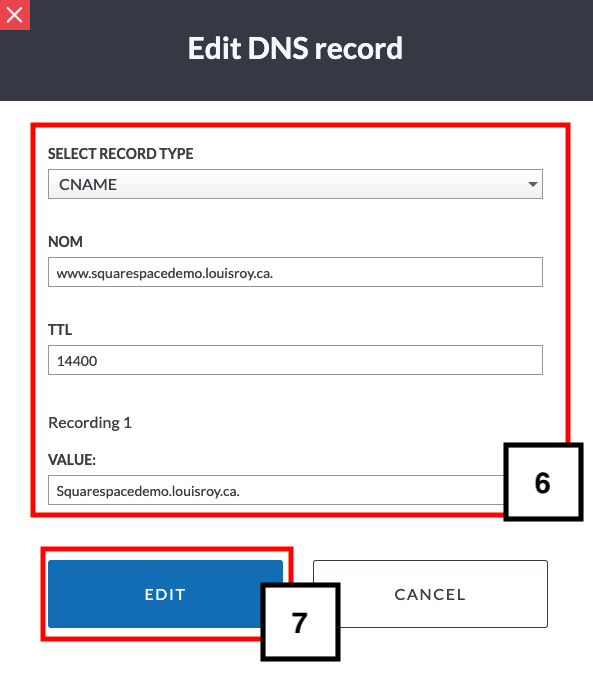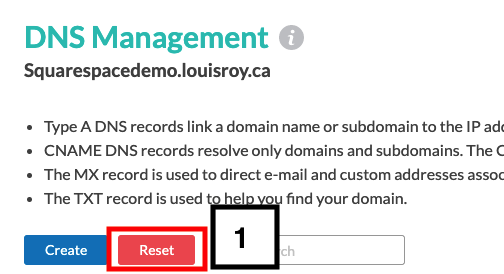Overview
The purpose of this article is to explain how to manage DNS.
Please note that a delay between the modification and the time it is taken into consideration is always possible.
Prerequisite
Access to https://mg.n0c.com/en/.
DNS in a Nutshell
Before explaining the DNS management, some basic notions have to be understood to grasp this article.
Main Function of a DNS Server
DNS means Domain Name System.
A website is located on a server identified by an IP address. The IP address works well for computers but it is difficult to remember for humans: that is why the DNS protocol was developed.
Technically speaking, the DNS is in fact a database that associates domain names with IP addresses. This is why the DNS is often compared to a telephone directory that associates persons names (equivalent to domains) with telephone numbers (equivalent to IP addresses).
For example, if web users want to go to Google’s website, they will not type in the IP address, as it is too complex. Instead, they will type in the domain name that has been assigned to the website, namely “google.com” in our exemple. The DNS server will convert the domain name entered by the user into an IP address that will allow to obtain the site data.

The DNS makes it possible, in particular, to reach the web server of a specific domain or a mail server to which a user wishes to send an e-mail message.
AFNIC has published a short video explaining the DNS very well. You can watch it in French by entering this address in your browser: https://youtu.be/dcIrB8qRCbA.
DNS recording
A DNS recording is a string of letters — the syntax — which dictates the actions of a DNS server.
DNS Records Types
The following table provides the definition of DNS records you can use in N0C.
| Type | Meaning | Description |
| A and AAAA | Address | “A” maps domain names to a server IP address (typically, IPv4 32 bits addresses). « AAAA » maps domain names to 128 bits IPv6 addresses. |
| CNAME | Canonical name | Redirects a domain to a different domain. It indicates that the domain name is an alias of another canonical domain name. CNAME is often used to associate new sub-domains with an A recording of an existing domain. |
| CAA | Certification Authority Authorization | Allows domain name owners to specify which Certificate Authorities (CAs) are allowed to issue certificates containing their domain names. |
| DS | Delegation Signer | Contains the name of a delegation zone: this allows to transfer with confidence from a parent zone to a child zone. |
| MX | Mail Exchange | Used to direct e-mails sent to personalized addresses associated to a domain name. |
| PTR | Pointer Record | Responsible to map an IPV4 address to a CNAME record on the host. |
| NS | Name server | Indicates which server name has authority over the domain. |
| SOA | State of Authority | Records essential information such as when the domain was last updated, as well as its changes and other activities. |
| SRV | Service | Used to define a TCP service on which the domain operates. It defines the location (the host name and port number of the servers for the specified services.). |
| TXT | Text | Used to facilitate the search of the domain. |
How to Modify a DNS Record
- In the Sidebar menu, select Domains -> Domain Management.
- In Domain Management window, identify the domain needing its DNS to be managed (use the Search field if needed).
- Click on the DNS button:

- In the DNS Management window, identify the NAME of the DNS record to modify:

- Click on the Edit icon.
- In the Edit DNS record window, fill in the requested information in the fields, which vary depending on the type of record (see the table in the “Description of DNS Recording Fields” section):

- Click on the Edit button.
Description of DNS Recording Fields
| Field | Types Using the Field | Field Description |
| TITLE | All | Field name (for exemple, “test”, resulting in “test.NOM-DE-DOMAINE.COM”) |
| TTL | All | Time To Live : means how long to keep the DNS entry cached. The higher the value, the longer the DNS resolution will be kept in cache. |
| IP | A | IP address on which the field will resolve (IPv4). |
| IP | AAAA | IP address on which the field will resolve (IPv6). |
| VALUE | CNAME | Name of the canonical domain to which the subdomain or domain points. |
| DOMAIN | MX | Personalized address associated with the domain name to which to direct emails. The domain name must be fully qualified. |
| KEYTAG | DS | Short numeric value that can quickly identify the referenced DNSKEY record. |
| ALGO | DS | Algorithm of the referenced DNSKEY record. |
| DIGEST TYPE | DS | Hash algorithm used to create the referenced DNSKEY record. |
| DIGEST | DS | Cryptographic hash value of the referenced DNSKEY record. |
| PRIORITY | MX, SRV | A lower value indicates a higher priority. |
| WEIGHT | SRV | When two services have the same priority, the number associated with the weight determines which line should arrive first. |
| PORT | SRV | Port number. |
| HOST | SRV | Host name. |
| CONTENT | TXT | Gross value of the record. |
How to Create a DNS Record
- In the Sidebar menu, select Domains -> Domain Management.
- In Domain Management window, identify the domain needing its DNS to be created (use the Search field if needed).
- Click on the DNS button.
- In the DNS Management window, click on the Create button:

- In the Create New DNS Record window SELECT RECORD TYPE (A, AAAA, CNAME, etc.):

- Fill in the requested information in the fields (see the table in the “Description of DNS Recording Fields” section).
- Click on the CREATE button.
How to Export the DNS Zone
It is possible to export a DNS zone in JSON data format.
- In the DNS Management window, click on the Export DNS Zone button:

- The JSON file is automatically saved in your Downloads folder.
How to Fully Reset the Zone
- In the DNS Management window for the chose domain, click on the Reset button:

- Confirm the action.
DNS Lookup for a Domain
The purpose of this tool is to analyze all records present in a domain’s DNS zone to ensure that the configuration is correct.
The tool is handy, among other things, for making sure name servers point to the right place. It is also quite useful for users who need to configure their domain used at Shopify or other platforms.
To access this tool, enter this address in your browser:https://www.ns-lookup.io/. Then:
1. Enter the domain name in the text field:

2. Click on the DNS lookup button.
Under Status, a blue check mark means that a configuration is present and a red check mark means that it is absent:
